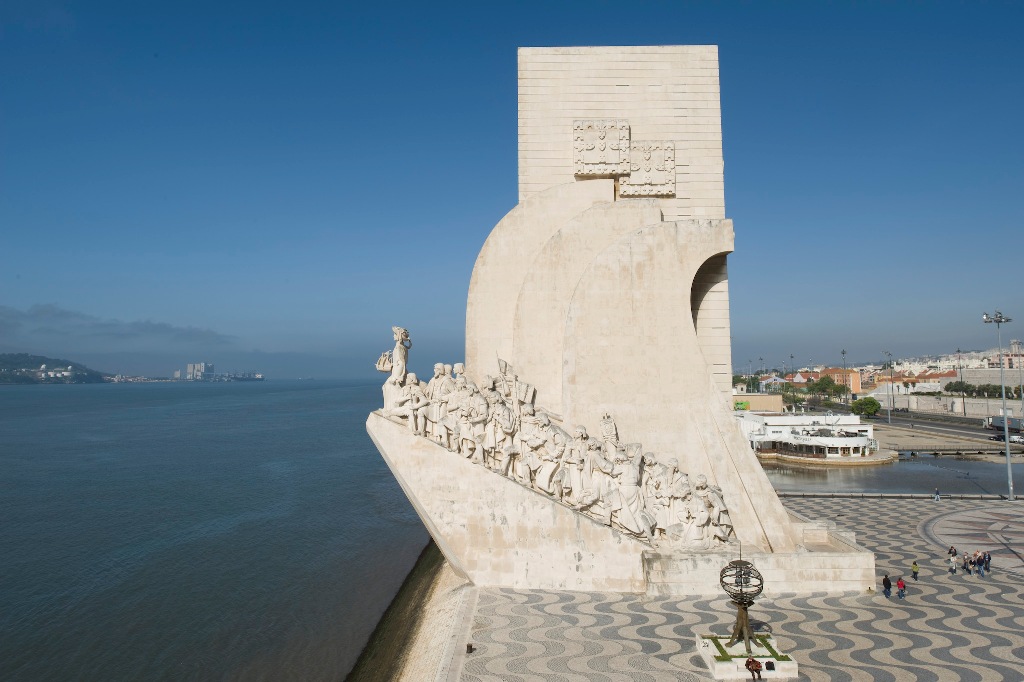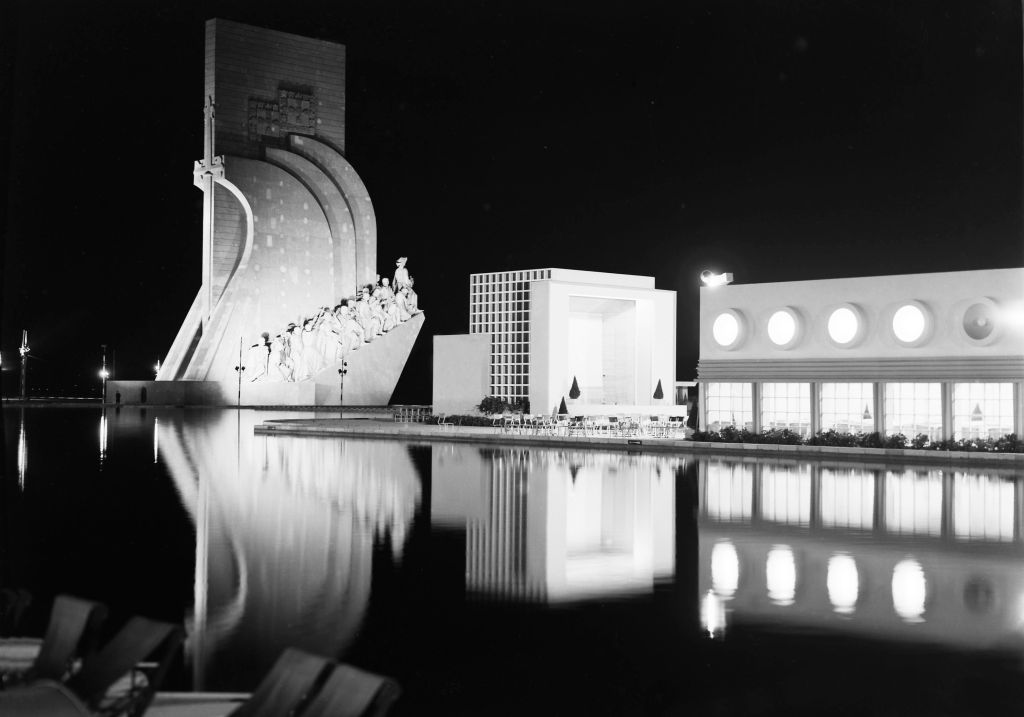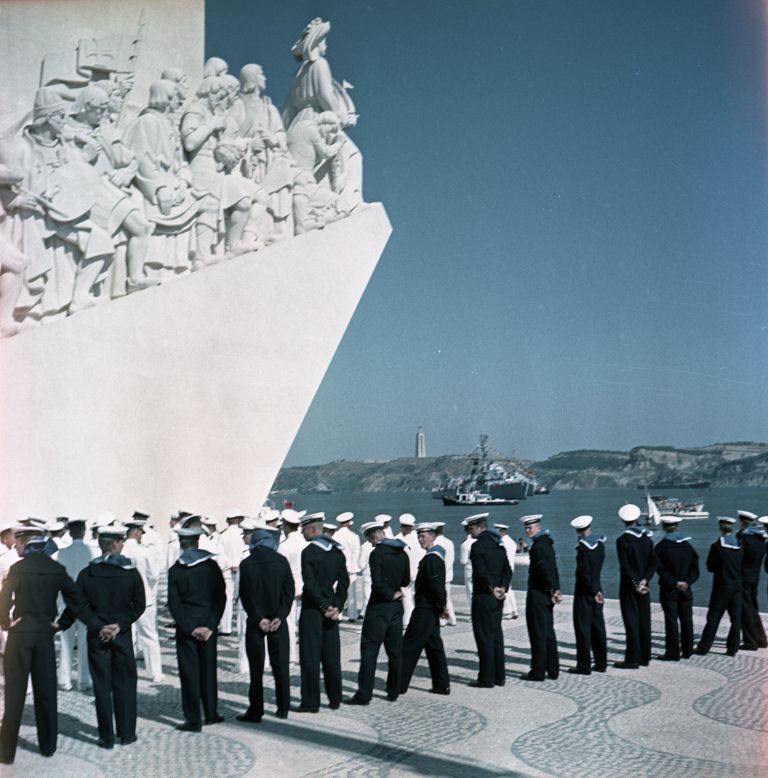Monument to the Discoveries
The Monument

Created by Cottinelli Telmo (1897–1948) and the sculptor Leopoldo de Almeida (1898–1975), Padrão dos Descobrimentos was first erected in 1940, in a temporary form, as part of the Portuguese World Exhibition, built with perishable materials. It had a light iron and cement frame, while the moulded sculpture had a light iron and cement frame, while the moulded sculpture was made of gypsum (formed of plaster and burlap, and reinforced by a wooden and iron structure).
The monument was reconstructed in 1960 to mark 500 years since the death of the Infante Dom Henrique (Henry the Navigator). This time it was made of concrete and rose-tinted Leiria stone masonry, with the sculptures made of Sintra limestone masonry.
The Centro Cultural das Descobertas was opened in 1985. Architect Fernando Ramalho remodelled the interior, giving the monument a viewpoint, auditorium and exhibition hall.
A stylised caravel seems to be setting out to sea, with Henry the Navigator in its prow. On the two lateral ramps ascending to the symbolic figure of the Prince are some of the significant characters of the Portuguese overseas expansion and cultural names from the age of the Discoveries, 32 in total, all portrayed with symbols that allude to their identity: navigators, cartographers, warriors, colonisers, missionaries, chroniclers and artists.
Composed of a vertical element consisting of a stylised mast oriented North-South, with two Portuguese coats of arms on each side with its five small shields, surrounded by a band with 12 castles and stylised fleurs-de-lis in the centre.
On each side are three triangular structures, each with one curved side, giving the illusion of sails blown out by the wind.
The north side is formed by two giant stones which bear inscriptions in metallic letters. On the left side, the inscription above an anchor reads ‘TO THE INFANTE DOM HENRIQUE AND THE PORTUGUESE WHO DISCOVERED THE SEA ROUTES’. On the other side, the inscription above a laurel wreath reads, ‘ON THE V CENTENARY OF THE INFANTE DOM HENRIQUE 1460–1960′.
In the middle of the monument, a flight of nine steps gives access to a platform with a view over the entire surrounding area.
The second flight of five stairs and a portal with a round arch formed by vaulted stones lead through to the interior of the monument.
The monument is flanked by two metal armillary spheres on two parallelepiped platforms.
Dimensions and features:
Height – 56m; Width – 20m; Length – 46m; Foundations – 20m
Central figure (Infante) – 9m; Figures on the sides (32) – 7m
Flyer about the Monument to the Discoveries
1940 The Portuguese World Exhibition

The decision to build the Portuguese World Exhibition in Belém made the most of the symbolic relationship between Portugal and the River Tagus, and more specifically the place from where boats embarked on exploring unknown seas and lands from the 14th century onwards. The Jerónimos Monastery forms the backdrop, extending the exhibition space from the Praça Afonso de Albuquerque to the Torre de Belém.
The exhibition was arranged around the Praça do Império, a space joining together the pavilions and special sections.
Forming a quadrangle with the ‘Monumental Fountain’ at its centre, the square was bounded by the main exhibition pavilions; the Pavilion of the Portuguese in the World, designed by Cottinelli Telmo, on the western side, and the Pavilion of Honour and Lisbon, designed by Cristino da Silva, on the eastern side. These pavilions were perpendicular to the river yet separated from it by the Avenida da Índia and the railway line. At the southern end of the square was the ‘Water Mirror’ by António Lino and the ‘Monument to the Discoveries’, also designed by Cottinelli Telmo in collaboration with Leopoldo de Almeida, situated alongside the Belém docks and in line with the square. Another symbolic element was the ‘Portuguese Ship’, a vessel created as a faithful replica of a Portuguese galleon from the 17th to 18th centuries.
